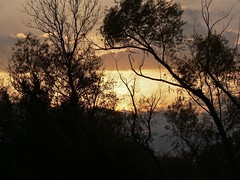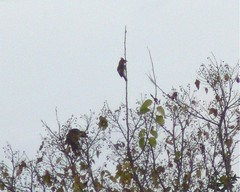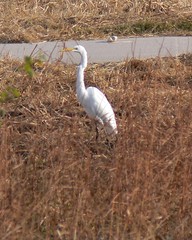 Despite being quite cold and windy, 8 people participated in this month's NASWC Bird Walk! We spent about 2 hours covering half a mile of Lake Creek Trail, starting at the Braes Valley parking lot. We found 30 species of birds despite the bitter weather and here are some of the highlights:
Despite being quite cold and windy, 8 people participated in this month's NASWC Bird Walk! We spent about 2 hours covering half a mile of Lake Creek Trail, starting at the Braes Valley parking lot. We found 30 species of birds despite the bitter weather and here are some of the highlights:As expected, a common bird this morning was the Yellow-rumped Warbler. We found them eating poison ivy berries and hackberries in a couple spots, and once or twice a few of us actually got to see their yellow rumps!
I was excited to see my first 2 Cedar Waxwings of the season. The first was across the creek and the second was near the footbridge. Both were in loose association with a few American Robins. Cedar Waxwings are winter birds in Texas and are usually found in flocks of 10 to 50 birds (sometimes larger) as they feed on fruits or berries. So it was interesting that these 2 were alone. I got this poor photo of the first one -- you can just make out the pointed crest, black mask, and yellow edge to the tail.
Continuing on the main trail downstream, we found an Eastern Phoebe, a Killdeer, and an American Pipit on the creek bed. And as we approached the footbridge we heard and saw many American Robins. One thing I never knew that Shirley LaVergne read in her field guide this morning is that male and female robins have a slightly different appearance. The males are darker overall and have a fuller red breast, while the females have a more faded red and are lighter overall. We saw great examples of each!
Here's a male:
And here's a female:
Thanks Shirley!
From the footbridge we got good close looks at some European Starlings. This is a common species, and it's easy to overlook the iridescence and intricate speckling which make it a beautiful bird. We also got to see the 2 largest birds you'll find on Lake Creek Trail: a Great Egret flew in and landed relatively close, and we got distant views of a Great Blue Heron. Here's the Great Egret.
On our way back we walked through the woods and I had the opportunity to ask Bill Dodd if he could identify a large low sprawling tree with heavily serrated leaves that I've wondered about for years. (I'm not so good at identifying plants.) Bill guessed it was an American Elm and verified the ID when he got home. I'm so used to our tall small-leafed Cedar Elms that I never thought this tree could be in the same family. Very cool, thanks Bill!
It was a fun morning. Thanks to everyone who came out in the cold!





3 comments:
Looks like a very satisfying trek! I swear; I WILL make it one of these months. Our Saturday dinner guests stayed and stayed...which was actually really nice.
Hey - question about a bird I saw along MoPac - it looked like a red-tailed hawk, but it had pretty distinctive white stripes on its backside, above its tail. - Juile
Wow! An American Elm? I think there is a registry for them. There is a disease called Dutch Elm disease that has wiped them out from much of North America. Most remaining American Elms have regular maintenance from humans, but there are some that are resistant to Dutch Elm disease - if this is a wild American Elm, it may be one of those!
I grew up with them, but haven't seen one for years.
Gracen Duffield
Julie, that was probably a Red-tailed Hawk. Sometimes they can have 2 light stripes making a V on their back.
Gracen, I'll have to look up the status of this tree species and see if I should report it somewhere!
Post a Comment